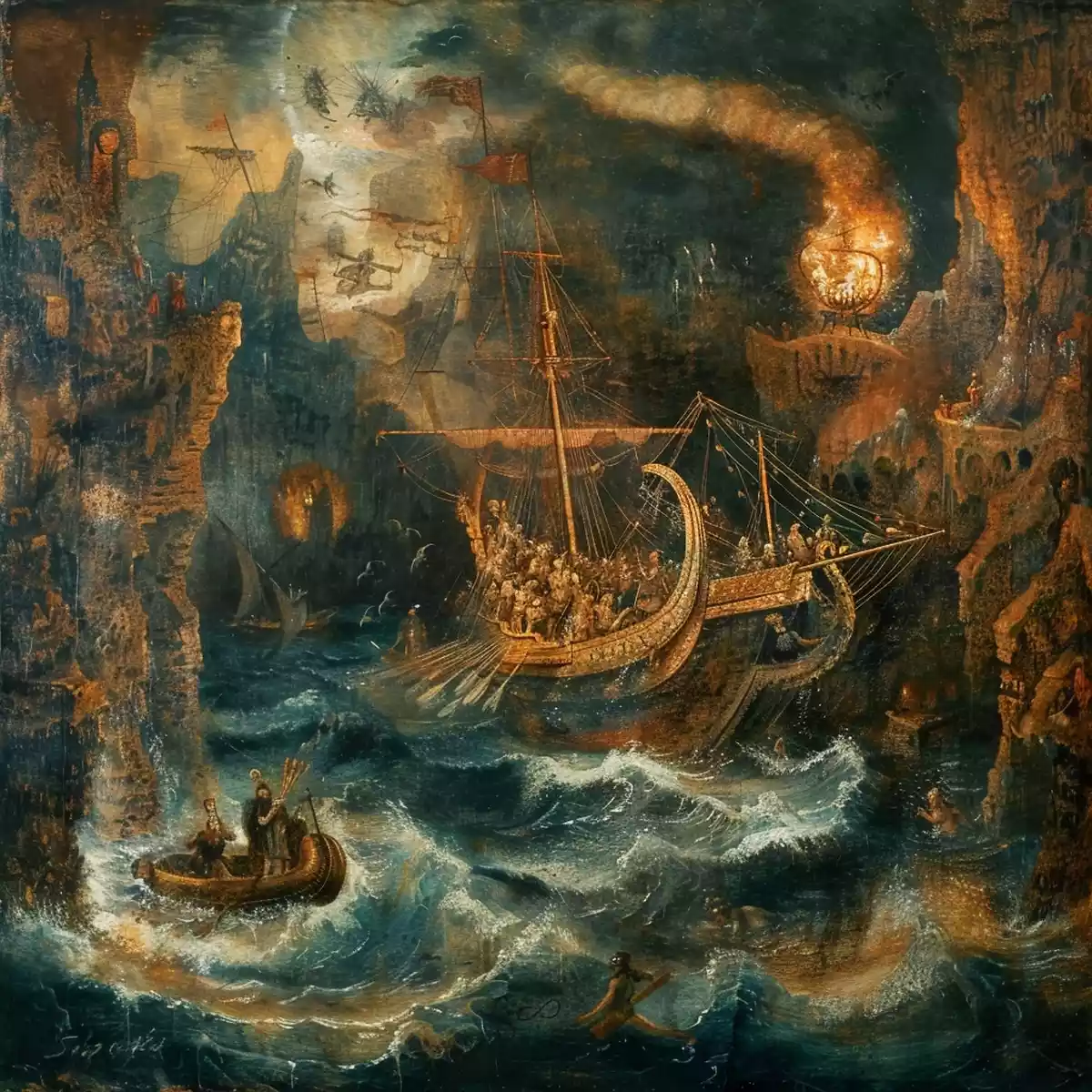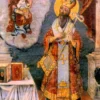
The Golden Fleece, one of the most iconic symbols of ancient Greek mythology, has fascinated and inspired generations of people throughout the centuries. The story of the Golden Fleece and the Argonautic Expedition, which is one of the most well-known and thrilling adventures of ancient Greek myths, has left an indelible mark on world literature, art, and culture.
The quest for the Golden Fleece begins with the hero Jason and the Argonauts, a group of brave men who embarked on an epic journey to retrieve the precious golden fleece from distant Colchis. Their story is filled with exciting adventures, mythical creatures, and divine interventions. As A.P. Psimopoulos mentions in his article “The Argonautic Expedition: The First Worldwide Naval Epic,” the Argonautic Expedition is the first worldwide naval epic, which inspired countless writers, artists, and intellectuals throughout the centuries.
The Quest for the Golden Fleece
The Golden Fleece, a mythical golden ram’s skin, is the focal point of the Argonautic Expedition, one of the most well-known and thrilling stories of Greek mythology. According to the myth, King Athamas of Orchomenus and his wife Nephele had two children, Phrixus and Helle. When Athamas remarried Ino, she became jealous of the children and plotted to kill them. Phrixus and Helle escaped on a golden ram sent by Zeus. During the journey, Helle fell from the ram and drowned in the sea, which was thereafter named the Hellespont. Phrixus reached Colchis, where he sacrificed the ram to Zeus and hung the golden fleece on a sacred tree, guarded by a dragon that never slept.
The Hunt for the Precious Fleece
Years later, Jason, the rightful heir to the throne of Iolcus, was ordered by his uncle Pelias to bring the Golden Fleece back to Greece as a condition to reclaim his kingdom. Jason gathered a group of heroes, the Argonauts, and embarked on the epic journey with the ship Argo. Among the Argonauts were Hercules, Orpheus, the Dioscuri Castor and Pollux, Theseus, and many other renowned heroes. As A.P. Psimopoulos points out, the Argonautic Expedition is the first worldwide naval epic, incorporating elements from various cultures and mythologies.
Adventures on the Journey to Colchis
During their journey, the Argonauts faced many challenges and adventures. They passed through the land of the Lemnian women, fought with the Giants in Cyzicus, and encountered the deadly Clashing Rocks. At each obstacle, the intelligence, strength, and unity of the Argonauts allowed them to triumph. These adventures not only depict the bravery and skills of the heroes but also highlight the importance of cooperation and determination in the face of adversity.
The Arrival in Colchis and the Acquisition of the Golden Fleece
When the Argonauts finally reached Colchis, King Aeetes promised Jason the Golden Fleece if he completed a series of seemingly impossible tasks. With the help of Aeetes’ daughter, the sorceress Medea, who had fallen in love with Jason, the hero managed to complete the tasks. Finally, Medea helped Jason steal the Golden Fleece by putting the guardian dragon to sleep with her magical abilities. The acquisition of the mythical treasure marked the culmination of the Argonauts’ mission and the fulfillment of Jason’s promise to Pelias.
The quest for the Golden Fleece represents a symbolic journey of self-discovery, courage, and growth for Jason and the Argonauts. Through their adventures and trials, the heroes discover their inner strength and develop bonds of friendship and solidarity. The Golden Fleece, as the ultimate prize, embodies both the triumph over external obstacles and personal growth and fulfillment.
The Symbolic Significance of the Golden Fleece
The Golden Fleece, beyond its physical existence as a valuable object, embodies multiple symbolic meanings and values. It represents the quest for knowledge, truth, and enlightenment, as the heroes overcome obstacles and trials to obtain it. The golden color of the fleece symbolizes perfection, immortality, and divine grace, while its coveted nature reflects the human desire for growth and transcendence of limits.
The Journey as a Metaphor for Life
The Argonautic Expedition can be interpreted as an allegory for the journey of life, with its challenges, discoveries, and personal growth. Each hero faces their own weaknesses and fears, but through cooperation and mutual support, they overcome obstacles and evolve. The journey of the Argonauts teaches us that perseverance, faith, and unity can lead us to achieve even the most difficult goals.
The Role of Fate and the Gods
Throughout the quest for the Golden Fleece, the role of fate and the intervention of the gods are evident. The gods, such as Hera and Athena, assist and guide the heroes, while at other times, they hinder their journey, like Apollo and Poseidon. The favor or displeasure of the gods largely determines the outcome of events, reflecting the ancient Greek belief in the importance of fate and divine intervention in human affairs.
The Importance of Leadership and Teamwork
Jason, as the leader of the Argonautic Expedition, embodies the characteristics of a capable leader: courage, acumen, and the ability to inspire his companions. However, the success of the endeavor is equally due to the teamwork and contribution of each Argonaut. The myth underscores the importance of collectivity and recognizing the value of each member of a team in achieving a common goal.
The story of the Golden Fleece and the Argonautic Expedition contains timeless lessons that continue to resonate in the modern era. It reminds us of the value of perseverance, companionship, and faith in ourselves and others. At the same time, it offers an exciting journey into the world of mythology, filled with adventures, magic, and heroism, that ignites the imagination and inspires the human soul timelessly.
The Golden Fleece in Art and Literature
The story of the Golden Fleece and the Argonautic Expedition has been a source of inspiration for countless works of art and literature throughout the centuries. From antiquity to the modern era, artists and writers have captured the adventures of Jason and the Argonauts, offering new interpretations and perspectives on the timeless myth. As E. Constantinescu points out in his article “Golden Fleece” published in the journal Eruditio, the Golden Fleece has served as a symbol of the quest for knowledge and personal fulfillment in various cultural traditions.
Ancient Greek Literature and Art
In ancient Greek literature, the myth of the Golden Fleece is found in works such as “The Argonautica” by Apollonius of Rhodes and the “Argonautica” of Orpheus. These epics narrate in detail the adventures of the Argonauts, enriching the narrative with poetic descriptions and philosophical reflections. In the visual arts, scenes from the Argonautic Expedition are depicted on vases, mosaics, and sculptures, testifying to the popularity and significance of the myth in ancient Greek culture.
Medieval and Renaissance Art
During the Middle Ages and the Renaissance, the myth of the Golden Fleece was adapted to Christian contexts, with Jason being paralleled to Christ and the Golden Fleece symbolizing spiritual quest and redemption. Artists such as Sandro Botticelli and John William Waterhouse depicted scenes from the story, giving an aesthetic and allegorical dimension to the myth. These interpretations reflect the adaptability and ability of the myth to acquire new meanings in different cultural contexts.
Modern Literature and Culture
In the modern era, the Golden Fleece continues to captivate the imagination of writers and artists. Literary works such as “The Arrival of the Argonauts” by Mary Renault and “The Aeolus of the Argonauts” by John Gardner offer new insights into the story, focusing on the psychology of the characters and the complex dynamics of their relationships. Movies, television series, and video games have also drawn inspiration from the myth, adapting it to new genres and forms of expression.
The timeless allure of the myth of the Golden Fleece lies in its ability to touch upon universal themes and values that pertain to the human experience. The quest for knowledge, overcoming obstacles, the power of friendship and cooperation are messages that continue to resonate in every era. As J.K. Newman observes in his work “Brill’s Companion to Apollonius Rhodius,” the Argonautic Expedition is an archetypal journey that embodies the human desire for exploration, discovery, and self-realization. Through art and literature, the myth of the Golden Fleece continues to inspire us and challenge us to reflect on our own journey of quest and growth.
The Return of the Argonauts and the Consequences
After acquiring the Golden Fleece, Jason, Medea, and the Argonauts began their journey back to Iolcus. However, their path was not without adventures and challenges. They faced the wrath of Zeus, who, enraged by the murder of Absyrtus, Medea’s brother, sent storms and adverse winds to hinder their progress. Nevertheless, with perseverance and courage, the heroes managed to overcome the obstacles and finally reach their homeland.
The Tragic Fate of Jason and Medea
The return to Iolcus, however, did not mark the happy ending that Jason and Medea had hoped for. Pelias refused to hand over the throne to Jason, despite the fulfillment of his mission. In a tragic twist of fate, Medea, using her magical abilities, convinced Pelias’ daughters to kill him, promising to resurrect him young. The death of Pelias led Jason and Medea into exile in Corinth, where their relationship met a painful and violent end, with Medea murdering her own children as revenge for Jason’s betrayal.
The Destiny of the Argonauts
After completing their mission, the Argonauts followed different paths, each leaving their mark on history and myth. Hercules continued his labors, becoming one of the most famous heroes of Greek mythology. Orpheus, with his musical prowess, attempted to save his beloved Eurydice from Hades. The Dioscuri, Castor and Pollux, were honored as protectors of sailors and travelers. Each Argonaut left their imprint, making the Argonautic Expedition a story not only about the quest for a mythical treasure but also about the power of friendship, devotion, and heroism.
The Legacy of the Argonautic Expedition
The story of the Argonautic Expedition and the Golden Fleece has left an indelible mark on global culture. From antiquity to the modern era, the myth has been a source of inspiration for countless artists, writers, and thinkers. It has shaped literature, art, and philosophy, offering a lens through which we can explore fundamental issues of human existence – the journey of self-discovery, the quest for truth, the power of will, and the confrontation with destiny.
The Golden Fleece, as a symbol of desire and fulfillment, invites us to reflect on our own journeys of quest and discovery. It reminds us that the true reward does not always lie in the prize itself, but in the lessons we learn, the bonds we build, and the inner growth we experience along the way. Like Jason and the Argonauts, we too are called to overcome obstacles, face our fears, and seek our own Golden Fleece – the ultimate symbol of our personal fulfillment and self-realization.
Epilogue
The quest for the Golden Fleece and the Argonautic Expedition are among the most captivating and timeless myths of Greek mythology. Through the exploration of the symbolic significance, artistic depiction, and philosophical interpretation of the myth, fundamental truths about human existence emerge – the quest for knowledge, overcoming obstacles, the power of companionship, and the pursuit of personal fulfillment. The Golden Fleece, as an archetypal symbol of desire and fulfillment, invites us to reflect on our own journeys of self-discovery and transformation, reminding us that the true reward lies in the lessons we learn and the inner growth we experience along the way. As a myth that continues to resonate in the modern era, the story of the Golden Fleece offers us a lens through which we can explore the deepest aspects of the human experience and draw inspiration for our own journeys of self-realization.
elpedia.gr
Bibliography
- Newman, J.K. “Imperial dream.” Brill’s Companion to Apollonius Rhodius, 2008, brill.com
- Psimopoulos, A.P. “The Argonautic Expedition: The First Worldwide Naval Epic.” International Journal of Literature Studies, 2021, al-kindipublisher
- Constantinescu, E. “Golden Fleece.” Education and the New Society of Knowledge, 2014, eruditio

